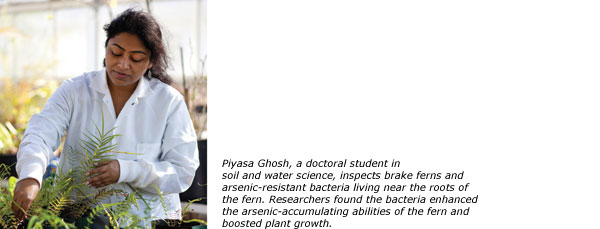Extracts

Bacteria that aid toxic cleanup could boost ag production
By Robert H. Wells
Remarkable bacteria that resist arsenic could improve toxic cleanups and boost agricultural production, according to a new UF study.
The bacteria were isolated from arsenic-contaminated soil surrounding the Chinese brake fern, a plant known for its ability to remove arsenic from the environment.
The carcinogen contaminates soils around the world and is deadly to most organisms.
Arsenic levels above state-set minimum standards were reported in residential areas in Miami and Gainesville, according to a 2003 study co-authored by Lena Ma, a UF soil and water science professor.
The findings, published in Bioresource Technology, could lead to improved phytoremediation — the process of using plants to remove environmental contaminants.
In the study, the bacteria broke arsenic down into a more easily absorbed form and increased the fern’s arsenic uptake ability by more than 900 percent. The bacteria also caused the plant to grow bigger, with a nearly 100-percent increase in root size.
“I really didn’t expect that the plant would grow better,” said Ma, an author of the study. “But the arsenic-resistant bacteria increased plant biomass.”
In 2001, Ma was the first to report the fern’s extraordinary arsenic accumulation abilities. Wanting to further increase the plant’s arsenic absorption capabilities, Ma, fellow UF Institute of Food and Agricultural Sciences member Bala Rathinasabapathi and soil and water science doctoral candidate Piyasa Ghosh, began examining bacteria living in the soil around the plant. Ghosh is the study’s lead author.
“We thought that there could be bacteria associated with the fern that could be useful in one way or another,” said Rathinasabapathi, a UF horticultural sciences associate professor.
The researchers collected soil near the fern and the fern’s root zone from different places in Florida contaminated with arsenic.
After the scientists isolated bacteria from the soil, they added it to the fern’s growing environment in the laboratory where it broke arsenic down into a more available form readily absorbed by the fern. In addition to the increase in arsenic absorption, they also noted a gain in the uptake of the nutrient phosphorus by the fern, which led to better growth.
Rathinasabapathi said more studies are needed to explore whether the bacteria can be widely used in agriculture.
The fern is licensed to and sold by a company based in Manhattan, Kan.